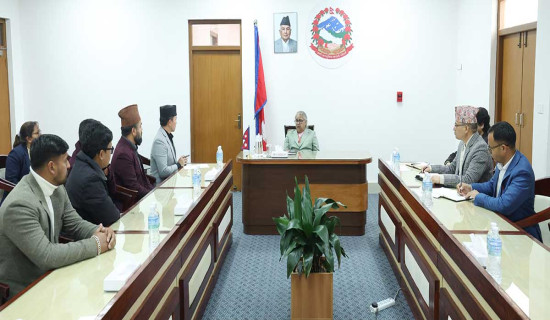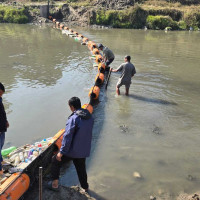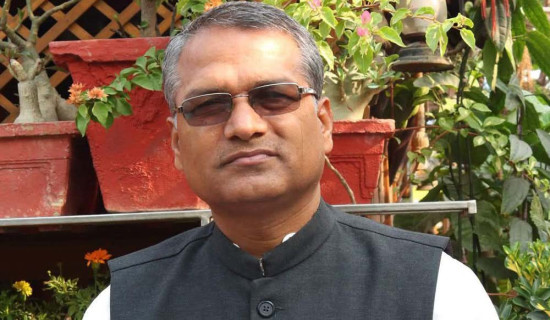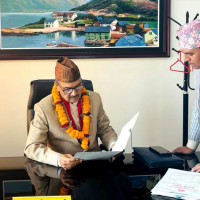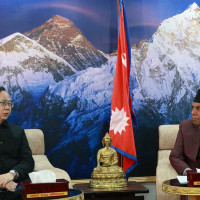- Sunday, 21 December 2025
Chemical drug abuse a burning problem
Kathmandu, June 13: Nepalis have been involved in marijuana cultivation and consumption for a long time. However, the trends have changed as people are getting attracted towards opiates and chemical drugs.
A report of Central Bureau of Statistics states that types and mode of drugs intake have changed in the last few decades as people started to take drugs like heroin, cocaine, buprenorphine, diazepam and phenergan, among others.
While marijuana is found widely across Nepal, opiates and chemical drugs are imported from India.
Nepalis can get access to marijuana easily though its production is destroyed in hectares of land and thousands of kilograms of the drug is seized annually by authorities. However, people, especially youths and teenagers, are found attracted towards heroin, cocaine, amphetamine and pharmaceutical drugs, nowadays, said Dr. Bhisma Kumar Bhusal, chief narcotics control officer of Narcotics Drug Control Section (NDCS) under the Ministry of Home Affairs.
A report of the NDCS shows that there was a growth of 98 per cent in drug users in between 2006-2012. “The number of drug users has been increasing in an alarming rate till date,” said Dr. Bhusal.
Officials associated with narcotics control argue that Indian smugglers import marijuana from Nepal while Nepal imports chemical drugs from India.
“Open border has been a major challenge to curb smuggling of hard drugs into Nepal. Hundreds of middlemen and carriers are arrested and drugs worth millions seized but smugglers use new people by paying handsome amount,” said Superintendent of Police (SP) Jeevan Kumar Shrestha, spokesperson for Narcotics Control Bureau (NCB) of Nepal Police.
During a three-day operation started from May 20, the NCB had arrested six individuals, including two Indian nationals, for smuggling heroin aka brown sugar from India to Kathmandu via Jhapa district. A total of 246 grams heroin, worth Rs. 2.46 million was seized from the racket.
“Arresting middlemen and carriers doesn’t stop drug smuggling due to which we are prioritising effective investigation to identify key persons and bust the racket so that they won’t operate again,” said SP Shrestha.
In fiscal year 2020/21, Nepal Police had arrested more than 4,200 individuals on drug cases and seized 88.60 kilograms heroin, 59.44 kilograms cocaine and 219,997 tablets and 154,468 ampules of pharmaceutical drugs.
Since January 15, 2022, to April 13, 2022, Nepal Police data shows that 1,260 individuals were arrested under drug-related charges. While open border with India has been a major transit to smuggle drugs into Nepal, air routes have also been found to have been used for the purpose.
A Zambian woman and an Indian woman were arrested with seven kilograms heroin smuggled through the Tribhuvan International Airport on April 16.
The Zambian woman had flown to Nepal from South Africa via Qatar with the drugs while the Indian woman had come to receive the drugs.
While foreign nationals smuggle drugs personally through air routes, couriers have also been used. On March 10, the NCB had arrested a Nepali national from Birgunj Metropolitan City from a post office.
The bureau had sent a fake courier to Parsa in a bid to arrest the involved individual after they found drugs in a courier at the General Post Office which had arrived from the United Kingdom.
The courier contained 4.418 kilograms hashish moulded into chocolates and 500 tablets of amphetamine.
“The demand for chemical drugs and opiates is high in city areas like Kathmandu, Pokhara, Dharan, Biratnagar and Jhapa.
It is expensive and extremely hazardous to health but more youths and teenagers are being attracted towards it for recreation of mind,” said SP Shrestha.
SP Shrestha said that the authorities deployed for narcotics control didn’t have advanced resources and were bound to curb drug smuggling manually.
We are well aware of new modus operandi to smuggle drugs and the necessity of proper infrastructure. We are planning to buy some drug detection devices in the upcoming fiscal year through Home Ministry’s assistance, said Dr. Bhusal.
Dr. Bhusal also stressed that the government was conducting
awareness campaign across the country to motivate drug users to quit the bad habit.
“From marijuana, our focus has shifted towards opiates and chemical drugs.
It has been found that Nepalis seek hard drugs even when marijuana is cultivated and accessible nearby cheap. Hard drugs are turning more challenging,” said Dr. Bhusal.
We are moving forward by generating awareness to limit number of drug users so that there is no demand for hard drugs. Smugglers are also being arrested.
A new action plan has also been formed which has designated
responsibilities of all three tiers of the government for narcotics control, he added.



